Analyzing Employment Law Cases: Hardison Ltd and Deed's - Law Module
VerifiedAdded on 2022/12/16
|7
|1921
|51
Case Study
AI Summary
This document presents a detailed case study analysis of employment law, focusing on two scenarios: Hardison Ltd and Deed's Used Cars and Repairs. The Hardison Ltd case examines potential redundancies, including the situations of Tara (pregnant employee), Eliot (sloppy employee), and Jim (60-year-old employee requesting redundancy). It explores the legality of dismissal based on pregnancy, performance, and voluntary redundancy, referencing relevant employment law acts. The Deed's case involves Jo Mills, who faces issues including a grievance with her supervisor Rita, a request for flexible working, and a potential constructive dismissal. The analysis covers grievance procedures, constructive dismissal definitions, and the legal right to request flexible working, while also addressing the employee's concerns about potential repercussions. Both cases provide legal positions and solutions, offering a comprehensive overview of employment law principles and their practical application.
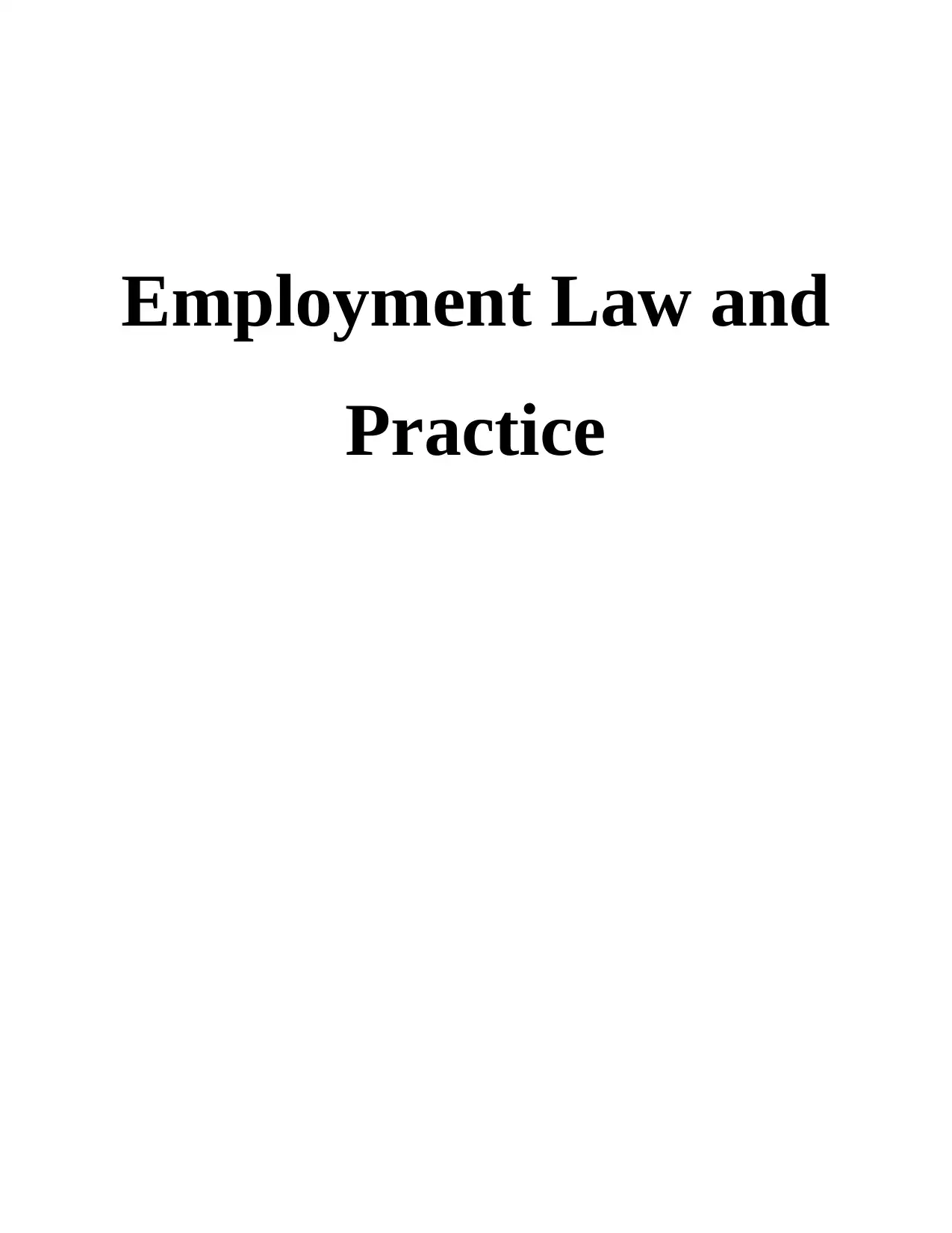
Employment Law and
Practice
Practice
Paraphrase This Document
Need a fresh take? Get an instant paraphrase of this document with our AI Paraphraser

Table of Contents
Part 1................................................................................................................................................3
Case study 1.................................................................................................................................3
Part 2................................................................................................................................................5
Case Study 2................................................................................................................................5
Part 1................................................................................................................................................3
Case study 1.................................................................................................................................3
Part 2................................................................................................................................................5
Case Study 2................................................................................................................................5
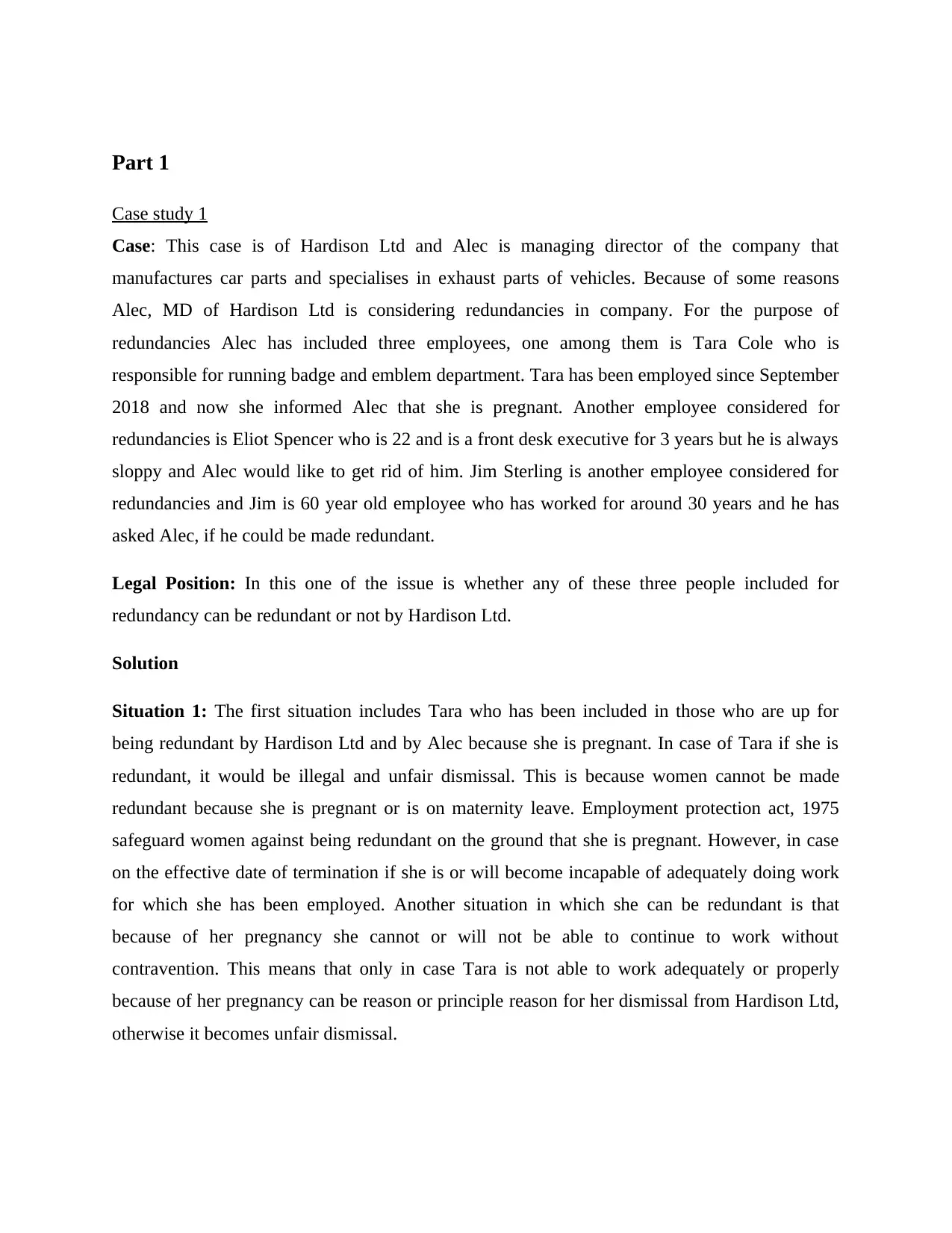
Part 1
Case study 1
Case: This case is of Hardison Ltd and Alec is managing director of the company that
manufactures car parts and specialises in exhaust parts of vehicles. Because of some reasons
Alec, MD of Hardison Ltd is considering redundancies in company. For the purpose of
redundancies Alec has included three employees, one among them is Tara Cole who is
responsible for running badge and emblem department. Tara has been employed since September
2018 and now she informed Alec that she is pregnant. Another employee considered for
redundancies is Eliot Spencer who is 22 and is a front desk executive for 3 years but he is always
sloppy and Alec would like to get rid of him. Jim Sterling is another employee considered for
redundancies and Jim is 60 year old employee who has worked for around 30 years and he has
asked Alec, if he could be made redundant.
Legal Position: In this one of the issue is whether any of these three people included for
redundancy can be redundant or not by Hardison Ltd.
Solution
Situation 1: The first situation includes Tara who has been included in those who are up for
being redundant by Hardison Ltd and by Alec because she is pregnant. In case of Tara if she is
redundant, it would be illegal and unfair dismissal. This is because women cannot be made
redundant because she is pregnant or is on maternity leave. Employment protection act, 1975
safeguard women against being redundant on the ground that she is pregnant. However, in case
on the effective date of termination if she is or will become incapable of adequately doing work
for which she has been employed. Another situation in which she can be redundant is that
because of her pregnancy she cannot or will not be able to continue to work without
contravention. This means that only in case Tara is not able to work adequately or properly
because of her pregnancy can be reason or principle reason for her dismissal from Hardison Ltd,
otherwise it becomes unfair dismissal.
Case study 1
Case: This case is of Hardison Ltd and Alec is managing director of the company that
manufactures car parts and specialises in exhaust parts of vehicles. Because of some reasons
Alec, MD of Hardison Ltd is considering redundancies in company. For the purpose of
redundancies Alec has included three employees, one among them is Tara Cole who is
responsible for running badge and emblem department. Tara has been employed since September
2018 and now she informed Alec that she is pregnant. Another employee considered for
redundancies is Eliot Spencer who is 22 and is a front desk executive for 3 years but he is always
sloppy and Alec would like to get rid of him. Jim Sterling is another employee considered for
redundancies and Jim is 60 year old employee who has worked for around 30 years and he has
asked Alec, if he could be made redundant.
Legal Position: In this one of the issue is whether any of these three people included for
redundancy can be redundant or not by Hardison Ltd.
Solution
Situation 1: The first situation includes Tara who has been included in those who are up for
being redundant by Hardison Ltd and by Alec because she is pregnant. In case of Tara if she is
redundant, it would be illegal and unfair dismissal. This is because women cannot be made
redundant because she is pregnant or is on maternity leave. Employment protection act, 1975
safeguard women against being redundant on the ground that she is pregnant. However, in case
on the effective date of termination if she is or will become incapable of adequately doing work
for which she has been employed. Another situation in which she can be redundant is that
because of her pregnancy she cannot or will not be able to continue to work without
contravention. This means that only in case Tara is not able to work adequately or properly
because of her pregnancy can be reason or principle reason for her dismissal from Hardison Ltd,
otherwise it becomes unfair dismissal.
⊘ This is a preview!⊘
Do you want full access?
Subscribe today to unlock all pages.

Trusted by 1+ million students worldwide
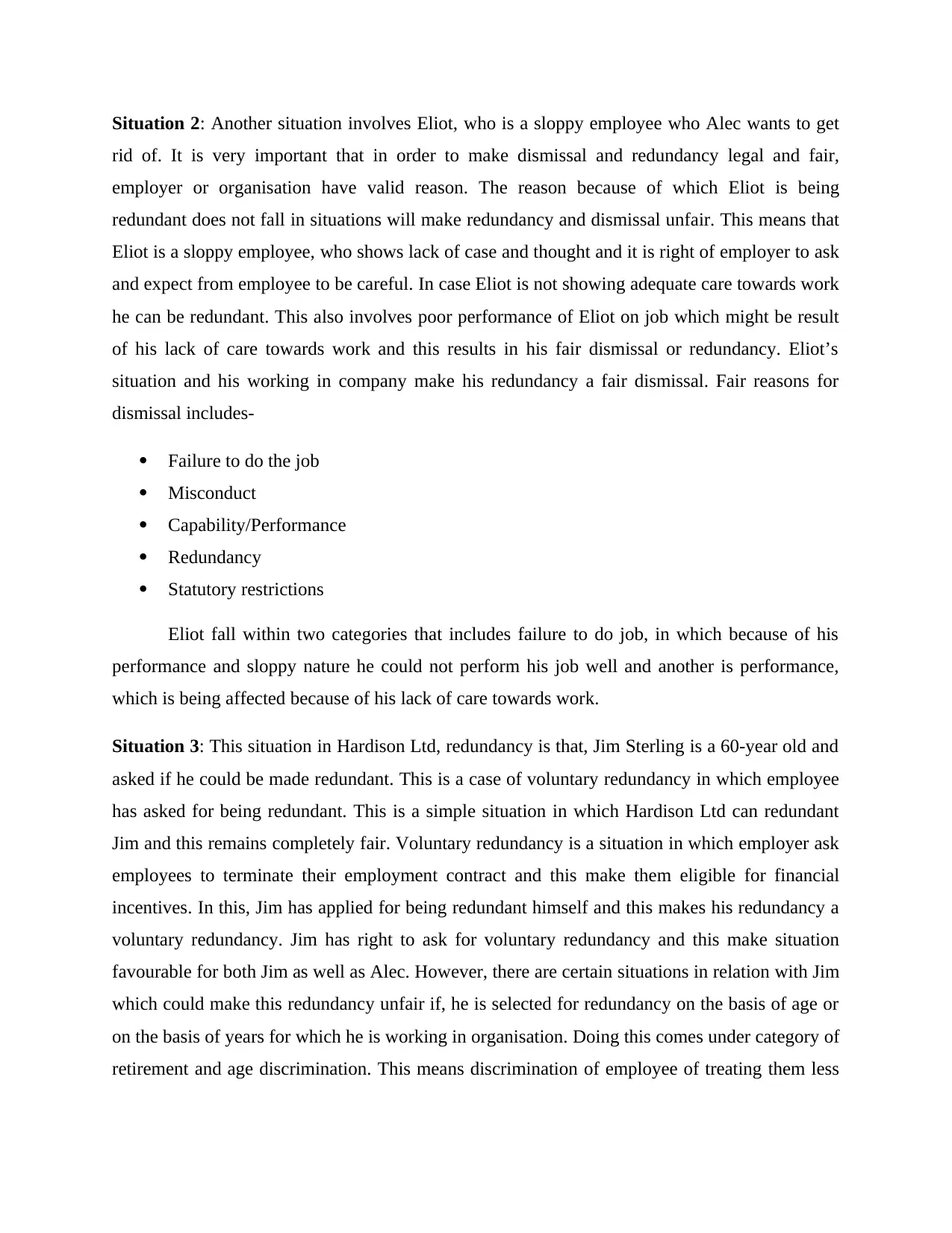
Situation 2: Another situation involves Eliot, who is a sloppy employee who Alec wants to get
rid of. It is very important that in order to make dismissal and redundancy legal and fair,
employer or organisation have valid reason. The reason because of which Eliot is being
redundant does not fall in situations will make redundancy and dismissal unfair. This means that
Eliot is a sloppy employee, who shows lack of case and thought and it is right of employer to ask
and expect from employee to be careful. In case Eliot is not showing adequate care towards work
he can be redundant. This also involves poor performance of Eliot on job which might be result
of his lack of care towards work and this results in his fair dismissal or redundancy. Eliot’s
situation and his working in company make his redundancy a fair dismissal. Fair reasons for
dismissal includes-
Failure to do the job
Misconduct
Capability/Performance
Redundancy
Statutory restrictions
Eliot fall within two categories that includes failure to do job, in which because of his
performance and sloppy nature he could not perform his job well and another is performance,
which is being affected because of his lack of care towards work.
Situation 3: This situation in Hardison Ltd, redundancy is that, Jim Sterling is a 60-year old and
asked if he could be made redundant. This is a case of voluntary redundancy in which employee
has asked for being redundant. This is a simple situation in which Hardison Ltd can redundant
Jim and this remains completely fair. Voluntary redundancy is a situation in which employer ask
employees to terminate their employment contract and this make them eligible for financial
incentives. In this, Jim has applied for being redundant himself and this makes his redundancy a
voluntary redundancy. Jim has right to ask for voluntary redundancy and this make situation
favourable for both Jim as well as Alec. However, there are certain situations in relation with Jim
which could make this redundancy unfair if, he is selected for redundancy on the basis of age or
on the basis of years for which he is working in organisation. Doing this comes under category of
retirement and age discrimination. This means discrimination of employee of treating them less
rid of. It is very important that in order to make dismissal and redundancy legal and fair,
employer or organisation have valid reason. The reason because of which Eliot is being
redundant does not fall in situations will make redundancy and dismissal unfair. This means that
Eliot is a sloppy employee, who shows lack of case and thought and it is right of employer to ask
and expect from employee to be careful. In case Eliot is not showing adequate care towards work
he can be redundant. This also involves poor performance of Eliot on job which might be result
of his lack of care towards work and this results in his fair dismissal or redundancy. Eliot’s
situation and his working in company make his redundancy a fair dismissal. Fair reasons for
dismissal includes-
Failure to do the job
Misconduct
Capability/Performance
Redundancy
Statutory restrictions
Eliot fall within two categories that includes failure to do job, in which because of his
performance and sloppy nature he could not perform his job well and another is performance,
which is being affected because of his lack of care towards work.
Situation 3: This situation in Hardison Ltd, redundancy is that, Jim Sterling is a 60-year old and
asked if he could be made redundant. This is a case of voluntary redundancy in which employee
has asked for being redundant. This is a simple situation in which Hardison Ltd can redundant
Jim and this remains completely fair. Voluntary redundancy is a situation in which employer ask
employees to terminate their employment contract and this make them eligible for financial
incentives. In this, Jim has applied for being redundant himself and this makes his redundancy a
voluntary redundancy. Jim has right to ask for voluntary redundancy and this make situation
favourable for both Jim as well as Alec. However, there are certain situations in relation with Jim
which could make this redundancy unfair if, he is selected for redundancy on the basis of age or
on the basis of years for which he is working in organisation. Doing this comes under category of
retirement and age discrimination. This means discrimination of employee of treating them less
Paraphrase This Document
Need a fresh take? Get an instant paraphrase of this document with our AI Paraphraser
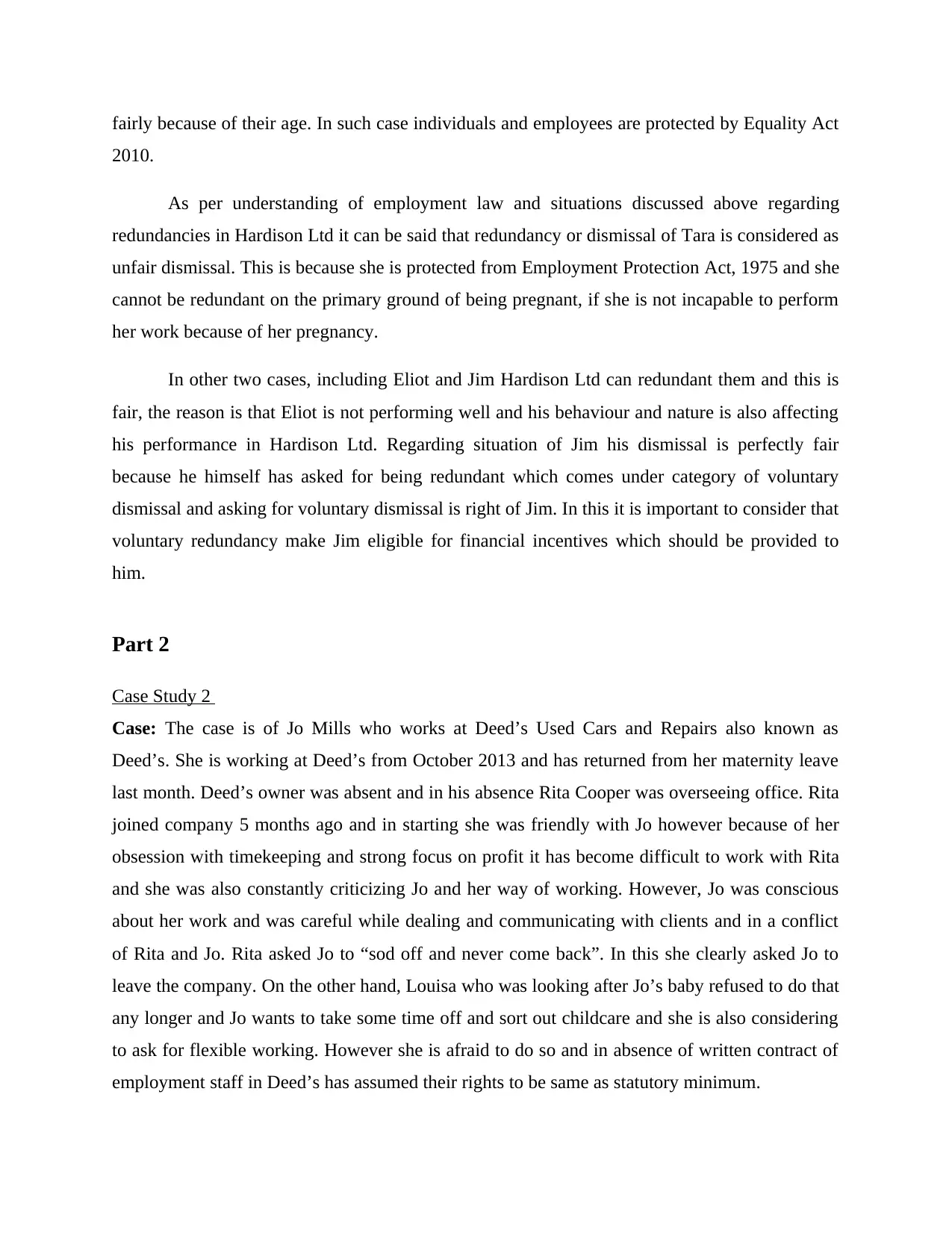
fairly because of their age. In such case individuals and employees are protected by Equality Act
2010.
As per understanding of employment law and situations discussed above regarding
redundancies in Hardison Ltd it can be said that redundancy or dismissal of Tara is considered as
unfair dismissal. This is because she is protected from Employment Protection Act, 1975 and she
cannot be redundant on the primary ground of being pregnant, if she is not incapable to perform
her work because of her pregnancy.
In other two cases, including Eliot and Jim Hardison Ltd can redundant them and this is
fair, the reason is that Eliot is not performing well and his behaviour and nature is also affecting
his performance in Hardison Ltd. Regarding situation of Jim his dismissal is perfectly fair
because he himself has asked for being redundant which comes under category of voluntary
dismissal and asking for voluntary dismissal is right of Jim. In this it is important to consider that
voluntary redundancy make Jim eligible for financial incentives which should be provided to
him.
Part 2
Case Study 2
Case: The case is of Jo Mills who works at Deed’s Used Cars and Repairs also known as
Deed’s. She is working at Deed’s from October 2013 and has returned from her maternity leave
last month. Deed’s owner was absent and in his absence Rita Cooper was overseeing office. Rita
joined company 5 months ago and in starting she was friendly with Jo however because of her
obsession with timekeeping and strong focus on profit it has become difficult to work with Rita
and she was also constantly criticizing Jo and her way of working. However, Jo was conscious
about her work and was careful while dealing and communicating with clients and in a conflict
of Rita and Jo. Rita asked Jo to “sod off and never come back”. In this she clearly asked Jo to
leave the company. On the other hand, Louisa who was looking after Jo’s baby refused to do that
any longer and Jo wants to take some time off and sort out childcare and she is also considering
to ask for flexible working. However she is afraid to do so and in absence of written contract of
employment staff in Deed’s has assumed their rights to be same as statutory minimum.
2010.
As per understanding of employment law and situations discussed above regarding
redundancies in Hardison Ltd it can be said that redundancy or dismissal of Tara is considered as
unfair dismissal. This is because she is protected from Employment Protection Act, 1975 and she
cannot be redundant on the primary ground of being pregnant, if she is not incapable to perform
her work because of her pregnancy.
In other two cases, including Eliot and Jim Hardison Ltd can redundant them and this is
fair, the reason is that Eliot is not performing well and his behaviour and nature is also affecting
his performance in Hardison Ltd. Regarding situation of Jim his dismissal is perfectly fair
because he himself has asked for being redundant which comes under category of voluntary
dismissal and asking for voluntary dismissal is right of Jim. In this it is important to consider that
voluntary redundancy make Jim eligible for financial incentives which should be provided to
him.
Part 2
Case Study 2
Case: The case is of Jo Mills who works at Deed’s Used Cars and Repairs also known as
Deed’s. She is working at Deed’s from October 2013 and has returned from her maternity leave
last month. Deed’s owner was absent and in his absence Rita Cooper was overseeing office. Rita
joined company 5 months ago and in starting she was friendly with Jo however because of her
obsession with timekeeping and strong focus on profit it has become difficult to work with Rita
and she was also constantly criticizing Jo and her way of working. However, Jo was conscious
about her work and was careful while dealing and communicating with clients and in a conflict
of Rita and Jo. Rita asked Jo to “sod off and never come back”. In this she clearly asked Jo to
leave the company. On the other hand, Louisa who was looking after Jo’s baby refused to do that
any longer and Jo wants to take some time off and sort out childcare and she is also considering
to ask for flexible working. However she is afraid to do so and in absence of written contract of
employment staff in Deed’s has assumed their rights to be same as statutory minimum.
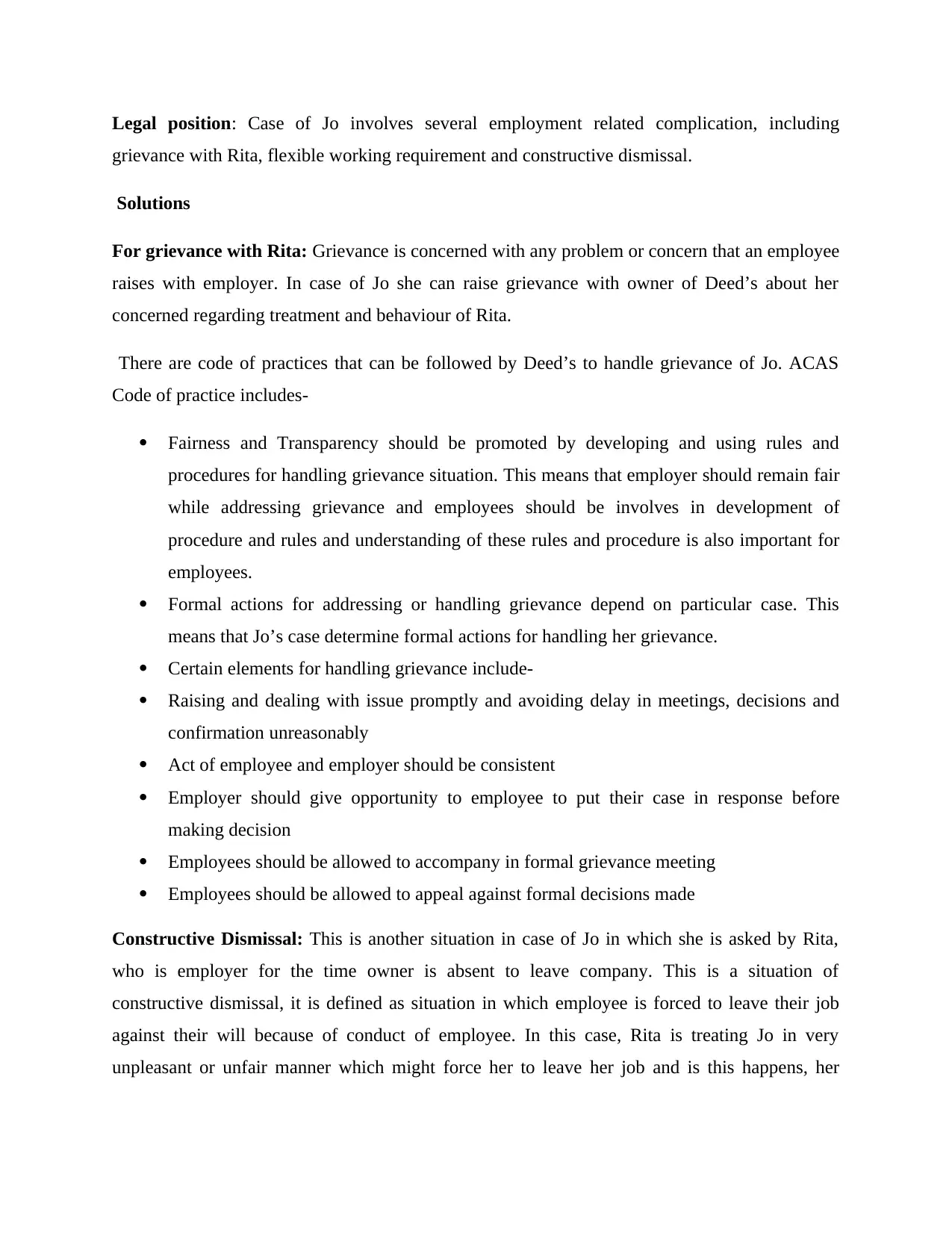
Legal position: Case of Jo involves several employment related complication, including
grievance with Rita, flexible working requirement and constructive dismissal.
Solutions
For grievance with Rita: Grievance is concerned with any problem or concern that an employee
raises with employer. In case of Jo she can raise grievance with owner of Deed’s about her
concerned regarding treatment and behaviour of Rita.
There are code of practices that can be followed by Deed’s to handle grievance of Jo. ACAS
Code of practice includes-
Fairness and Transparency should be promoted by developing and using rules and
procedures for handling grievance situation. This means that employer should remain fair
while addressing grievance and employees should be involves in development of
procedure and rules and understanding of these rules and procedure is also important for
employees.
Formal actions for addressing or handling grievance depend on particular case. This
means that Jo’s case determine formal actions for handling her grievance.
Certain elements for handling grievance include-
Raising and dealing with issue promptly and avoiding delay in meetings, decisions and
confirmation unreasonably
Act of employee and employer should be consistent
Employer should give opportunity to employee to put their case in response before
making decision
Employees should be allowed to accompany in formal grievance meeting
Employees should be allowed to appeal against formal decisions made
Constructive Dismissal: This is another situation in case of Jo in which she is asked by Rita,
who is employer for the time owner is absent to leave company. This is a situation of
constructive dismissal, it is defined as situation in which employee is forced to leave their job
against their will because of conduct of employee. In this case, Rita is treating Jo in very
unpleasant or unfair manner which might force her to leave her job and is this happens, her
grievance with Rita, flexible working requirement and constructive dismissal.
Solutions
For grievance with Rita: Grievance is concerned with any problem or concern that an employee
raises with employer. In case of Jo she can raise grievance with owner of Deed’s about her
concerned regarding treatment and behaviour of Rita.
There are code of practices that can be followed by Deed’s to handle grievance of Jo. ACAS
Code of practice includes-
Fairness and Transparency should be promoted by developing and using rules and
procedures for handling grievance situation. This means that employer should remain fair
while addressing grievance and employees should be involves in development of
procedure and rules and understanding of these rules and procedure is also important for
employees.
Formal actions for addressing or handling grievance depend on particular case. This
means that Jo’s case determine formal actions for handling her grievance.
Certain elements for handling grievance include-
Raising and dealing with issue promptly and avoiding delay in meetings, decisions and
confirmation unreasonably
Act of employee and employer should be consistent
Employer should give opportunity to employee to put their case in response before
making decision
Employees should be allowed to accompany in formal grievance meeting
Employees should be allowed to appeal against formal decisions made
Constructive Dismissal: This is another situation in case of Jo in which she is asked by Rita,
who is employer for the time owner is absent to leave company. This is a situation of
constructive dismissal, it is defined as situation in which employee is forced to leave their job
against their will because of conduct of employee. In this case, Rita is treating Jo in very
unpleasant or unfair manner which might force her to leave her job and is this happens, her
⊘ This is a preview!⊘
Do you want full access?
Subscribe today to unlock all pages.

Trusted by 1+ million students worldwide
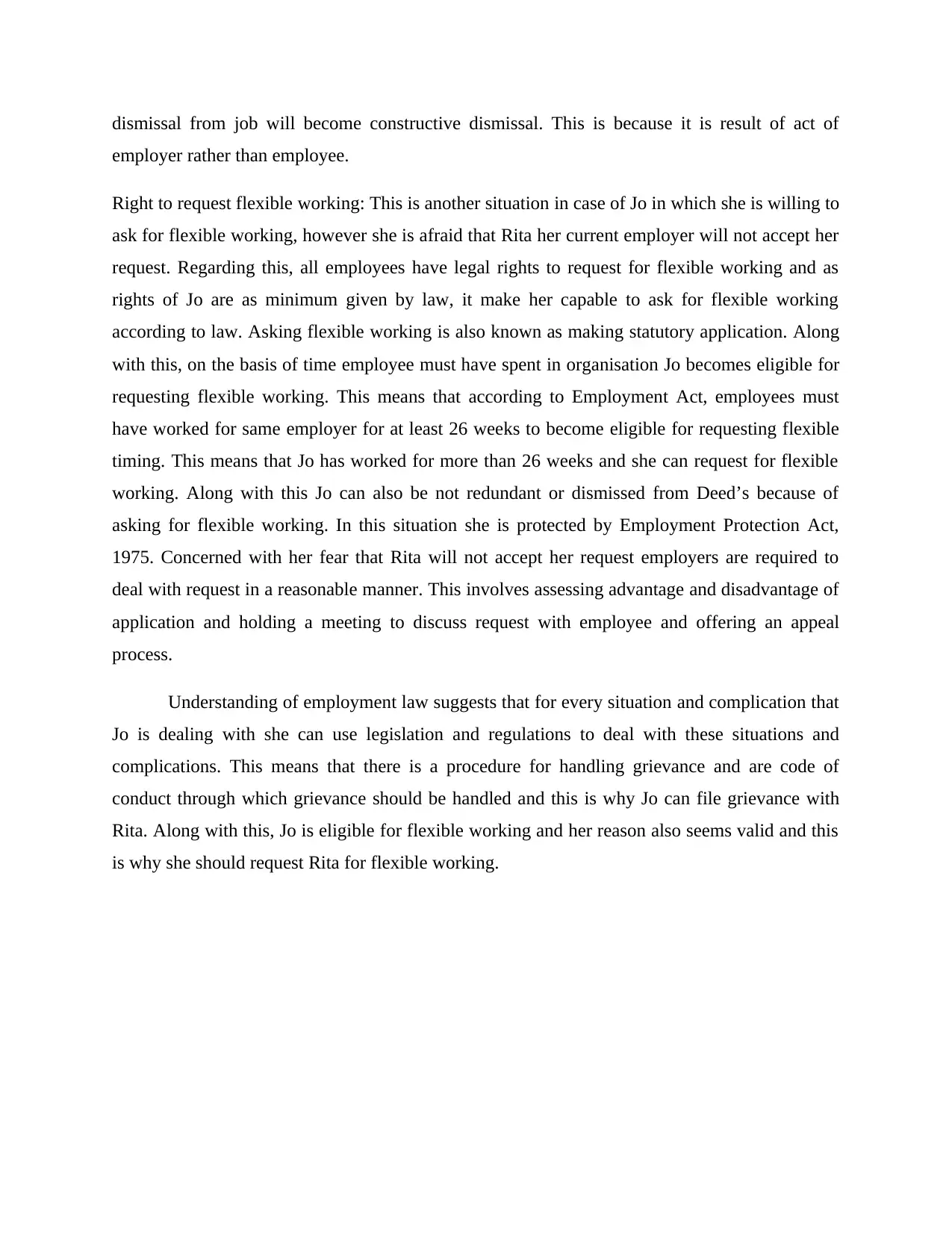
dismissal from job will become constructive dismissal. This is because it is result of act of
employer rather than employee.
Right to request flexible working: This is another situation in case of Jo in which she is willing to
ask for flexible working, however she is afraid that Rita her current employer will not accept her
request. Regarding this, all employees have legal rights to request for flexible working and as
rights of Jo are as minimum given by law, it make her capable to ask for flexible working
according to law. Asking flexible working is also known as making statutory application. Along
with this, on the basis of time employee must have spent in organisation Jo becomes eligible for
requesting flexible working. This means that according to Employment Act, employees must
have worked for same employer for at least 26 weeks to become eligible for requesting flexible
timing. This means that Jo has worked for more than 26 weeks and she can request for flexible
working. Along with this Jo can also be not redundant or dismissed from Deed’s because of
asking for flexible working. In this situation she is protected by Employment Protection Act,
1975. Concerned with her fear that Rita will not accept her request employers are required to
deal with request in a reasonable manner. This involves assessing advantage and disadvantage of
application and holding a meeting to discuss request with employee and offering an appeal
process.
Understanding of employment law suggests that for every situation and complication that
Jo is dealing with she can use legislation and regulations to deal with these situations and
complications. This means that there is a procedure for handling grievance and are code of
conduct through which grievance should be handled and this is why Jo can file grievance with
Rita. Along with this, Jo is eligible for flexible working and her reason also seems valid and this
is why she should request Rita for flexible working.
employer rather than employee.
Right to request flexible working: This is another situation in case of Jo in which she is willing to
ask for flexible working, however she is afraid that Rita her current employer will not accept her
request. Regarding this, all employees have legal rights to request for flexible working and as
rights of Jo are as minimum given by law, it make her capable to ask for flexible working
according to law. Asking flexible working is also known as making statutory application. Along
with this, on the basis of time employee must have spent in organisation Jo becomes eligible for
requesting flexible working. This means that according to Employment Act, employees must
have worked for same employer for at least 26 weeks to become eligible for requesting flexible
timing. This means that Jo has worked for more than 26 weeks and she can request for flexible
working. Along with this Jo can also be not redundant or dismissed from Deed’s because of
asking for flexible working. In this situation she is protected by Employment Protection Act,
1975. Concerned with her fear that Rita will not accept her request employers are required to
deal with request in a reasonable manner. This involves assessing advantage and disadvantage of
application and holding a meeting to discuss request with employee and offering an appeal
process.
Understanding of employment law suggests that for every situation and complication that
Jo is dealing with she can use legislation and regulations to deal with these situations and
complications. This means that there is a procedure for handling grievance and are code of
conduct through which grievance should be handled and this is why Jo can file grievance with
Rita. Along with this, Jo is eligible for flexible working and her reason also seems valid and this
is why she should request Rita for flexible working.
1 out of 7
Related Documents
Your All-in-One AI-Powered Toolkit for Academic Success.
+13062052269
info@desklib.com
Available 24*7 on WhatsApp / Email
![[object Object]](/_next/static/media/star-bottom.7253800d.svg)
Unlock your academic potential
Copyright © 2020–2025 A2Z Services. All Rights Reserved. Developed and managed by ZUCOL.





